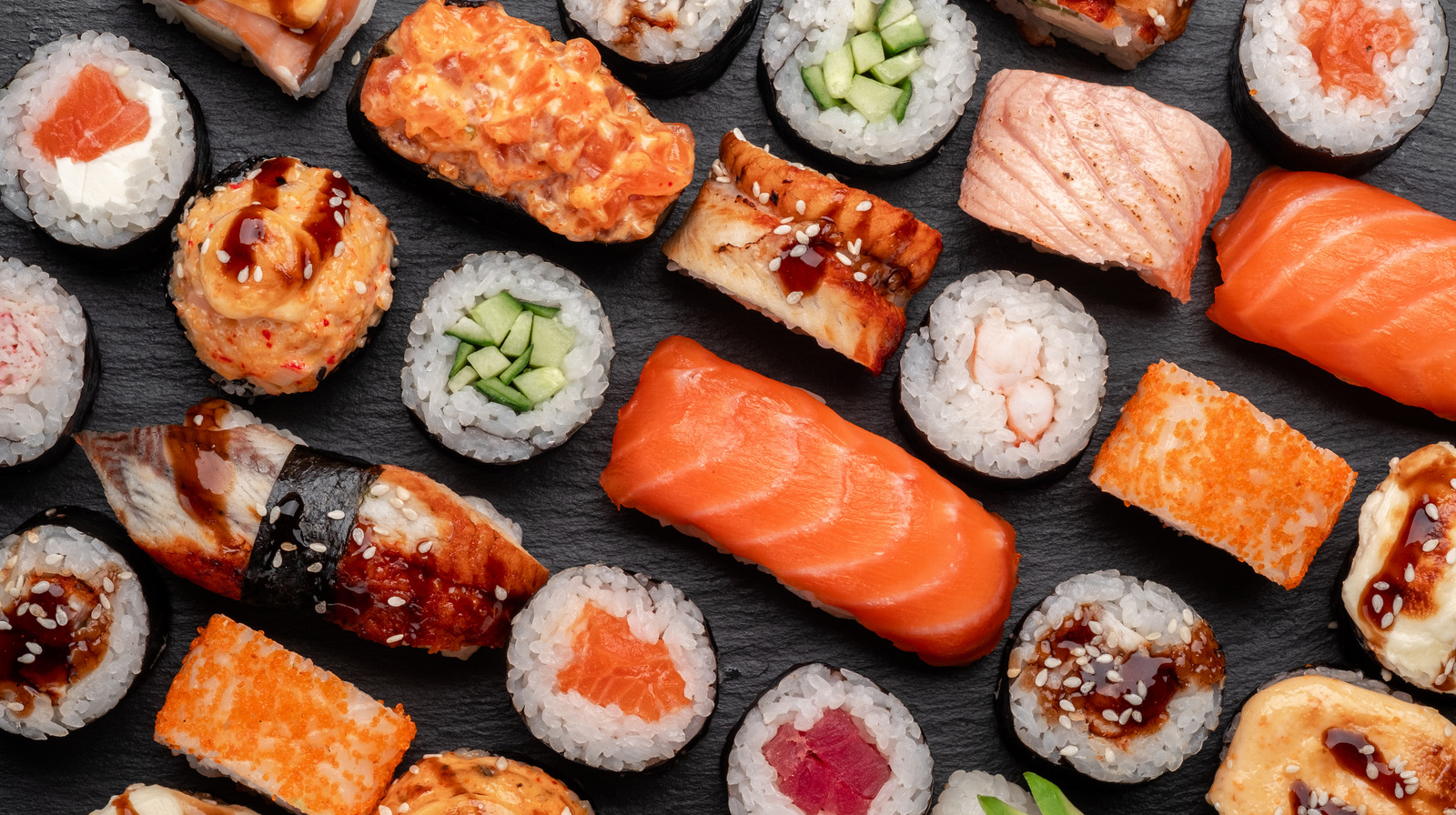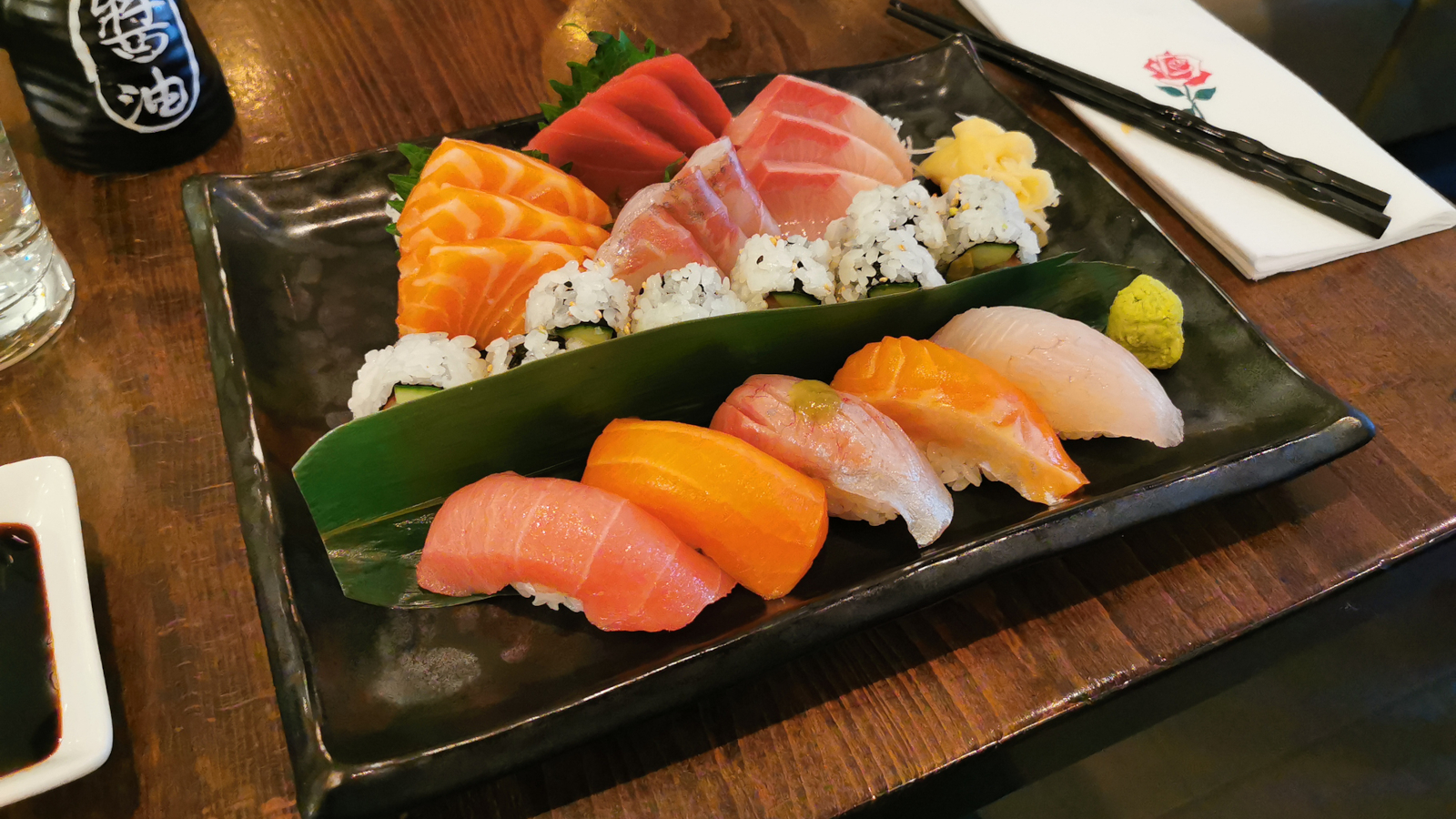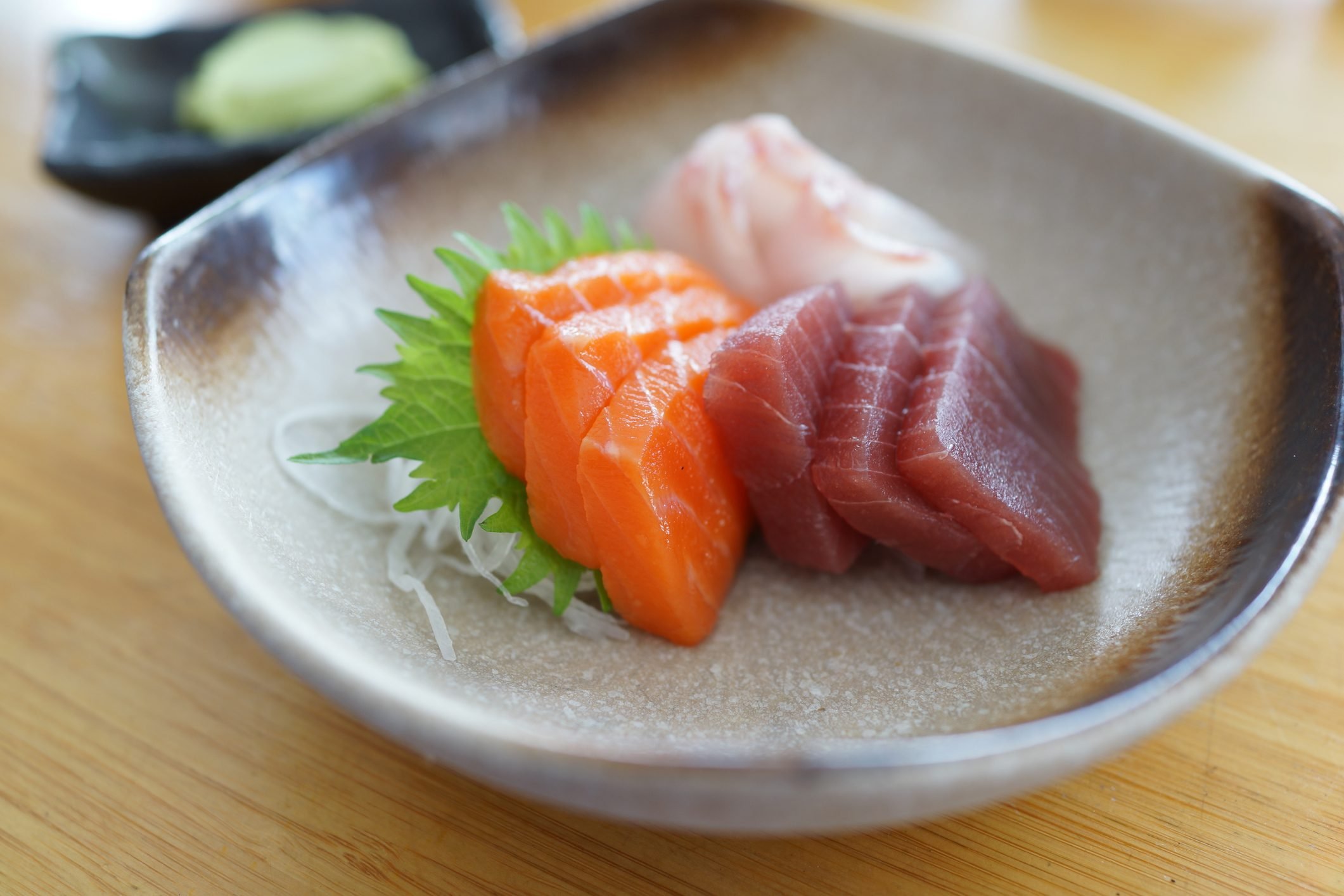Introduction
The Japanese cuisine offers a wide variety of dishes that are loved and enjoyed by people all over the world. Among these dishes, sushi and sashimi stand out as popular choices. While they may appear similar to the untrained eye, there are distinct differences between these two delicacies. This blog aims to break down the dissimilarities between sushi and sashimi, giving you the knowledge to make an informed choice the next time you visit a Japanese restaurant.
Understanding The Basics Of Sushi And Sashimi
To better understand the differences between sushi and sashimi, it is crucial to know the basic components of each dish.
- Sushi: Sushi is a traditional Japanese dish that combines vinegared rice with various fillings such as raw fish, cooked seafood, vegetables, and even omelets. The rice is the foundation of sushi, while the fillings provide the flavors and textures. Sushi is often wrapped in seaweed (nori) or served as bite-sized pieces known as nigiri sushi or rolled into cylindrical shapes called maki rolls.
- Sashimi: Sashimi, on the other hand, focuses solely on the sliced raw meat or fish without any rice or fillings. The quality and freshness of the ingredients are paramount in sashimi, as their natural flavors take center stage. Sashimi can be made from various types of fish, including tuna, salmon, yellowtail, and octopus, among others. It is commonly served with soy sauce and wasabi, allowing the diner to appreciate the pure taste of the seafood.
Importance Of Distinguishing Sushi And Sashimi
While sushi and sashimi share the use of raw fish, it is essential to recognize their differences to enhance your dining experience.
- Ingredients: Sushi incorporates a range of fillings and flavors, providing a well-rounded bite. Sashimi, on the other hand, allows for a more focused appreciation of the seafood’s taste.
- Preparation: Sushi involves the artful arrangement of ingredients on top of vinegared rice, while sashimi focuses solely on the presentation of perfectly sliced raw fish or meat.
- Presentation: Sushi is often served in bite-sized pieces, either as individual nigiri or rolls. Sashimi, on the other hand, is typically presented as thinly sliced pieces arranged on a plate.
By understanding the distinctions between sushi and sashimi, you can confidently navigate through a Japanese menu and choose the dish that best suits your preferences. So, next time you visit a Japanese restaurant, embrace your culinary curiosity and indulge in the diverse flavors of both sushi and sashimi.

Defining Sushi
Sushi is a traditional Japanese dish that showcases the skillful combination of vinegared rice and various fillings. While raw fish is often associated with sushi, it is important to note that not all sushi contains fish. The term “sushi” actually refers to the sour rice or vinegared rice used as the base for the dish. This rice is typically seasoned with a mixture of rice vinegar, sugar, and salt, giving it a unique tangy flavor. The fillings used in sushi can include raw fish (“sashimi”), cooked seafood, vegetables, and even omelets. The combination of rice and fillings provides a harmonious blend of flavors and textures that make sushi a delightful culinary experience.
Sushi: A Delightful Combination Of Ingredients
The beauty of sushi lies in its ability to bring together different ingredients to create a balanced and appetizing dish. The vinegared rice serves as the foundation, providing a slightly sweet and tangy taste that complements the other components. The fillings, whether it’s the freshness of raw fish or the crunch of vegetables, add depth and variety to each bite. Sushi can be enjoyed in different forms, including nigiri sushi, where a slice of fish or other toppings are placed on top of a small mound of rice, or maki rolls, where the ingredients are wrapped in seaweed and rolled tightly before being sliced into bite-sized pieces. Each type of sushi has its own unique characteristics and flavors, offering endless possibilities for exploration.
Types Of Sushi: Nigiri, Maki, And More
Sushi comes in various forms, each with its own distinct presentation and preparation style. Here are some popular types of sushi:
- Nigiri Sushi: Nigiri sushi consists of a slice of raw or cooked fish draped over a small oblong-shaped mound of vinegared rice. The fish is often lightly brushed with soy sauce or topped with a dab of wasabi for added flavor.
- Maki Sushi: Maki sushi, also known as sushi rolls, are made by wrapping the rice and fillings in a sheet of seaweed (nori) and then slicing it into individual bite-sized pieces. The fillings can include a variety of ingredients such as fish, vegetables, or even tempura.
- Sashimi Sushi: Sashimi, while technically not sushi, is an integral part of Japanese cuisine. It refers to thinly sliced raw fish or seafood that is served without rice. Sashimi allows the natural flavors of the fish to shine, and it is often accompanied by soy sauce and wasabi for dipping.
- Temaki Sushi: Temaki sushi, also known as hand rolls, are cone-shaped sushi rolls that are made by wrapping the rice and fillings in a larger piece of seaweed. They are often eaten with the hands, offering a fun and interactive dining experience.
Sushi is a versatile dish that can be customized according to individual preferences. Whether you prefer the simplicity of nigiri or the creativity of maki rolls, sushi offers a culinary adventure that is both satisfying and delicious.
Exploring Sashimi
Sashimi: The Art Of Raw Fish
Sashimi is a traditional Japanese dish that showcases the pure and delicate flavors of raw fish or seafood. Unlike sushi, sashimi does not include rice as a component. Instead, it consists of thinly sliced pieces of raw fish or seafood that are carefully arranged on a plain plate. The quality of the fish is crucial in sashimi, as it should be incredibly fresh and of high quality to ensure safe consumption. Sashimi allows the natural flavors and textures of the fish to shine, providing a sensory experience that is both subtle and nuanced.
Popular Types Of Sashimi: Salmon, Tuna, And More
Sashimi can be made from a wide variety of fish and seafood, each offering its own unique flavors and characteristics. Some popular types of sashimi include:
- Salmon: The rich, fatty flesh of fresh salmon is a favorite choice for sashimi. Its velvety texture and slightly sweet flavor make it a delicious option for seafood lovers.
- Tuna: Tuna sashimi is highly prized for its deep red color and rich, buttery taste. The meaty texture and mild flavor of tuna make it a versatile choice for sashimi.
- Yellowtail: Yellowtail sashimi is known for its firm yet tender flesh and delicate flavor. It is often enjoyed sliced thinly to highlight its natural sweetness.
- Octopus: Octopus sashimi offers a unique and slightly chewy texture. It is typically thinly sliced and has a subtle briny taste.
- Scallop: Fresh scallop sashimi boasts a delicate, buttery flavor and a tender texture. It is often enjoyed raw to savor its natural sweetness.
- Shrimp: Shrimp sashimi is a popular choice for those who prefer milder seafood flavors. Its sweet and slightly salty taste pairs well with soy sauce and wasabi.
Sashimi is typically served with soy sauce and wasabi for dipping, allowing you to customize the flavors to your liking. With its emphasis on the natural taste of raw fish or seafood, sashimi provides a unique culinary experience for those who appreciate the art of simplicity and purity in Japanese cuisine.
Ingredients And Presentation
Sushi Ingredients: Rice, Fish, Vegetables, And Condiments
Sushi is a dish that incorporates a variety of ingredients to create a harmonious combination of flavors and textures. The main components of sushi include:
- Rice: Sushi rice is a special type of short-grain rice that is seasoned with vinegar, sugar, and salt. It provides a sticky and slightly tangy base for the other ingredients.
- Fish: Raw fish, such as tuna, salmon, yellowtail, and eel, is a common ingredient in sushi. The fish should be of high quality and freshness to ensure a delicious and safe dining experience.
- Vegetables: Sushi can also include a variety of vegetables, such as cucumber, avocado, radish, and pickled daikon. These vegetables add crunch and freshness to the sushi rolls.
- Condiments: Sushi is often served with condiments like soy sauce, wasabi, and pickled ginger. Soy sauce is used for dipping the sushi, while wasabi adds a spicy kick. Pickled ginger is eaten between different sushi pieces to cleanse the palate.
Sashimi Presentation: Simplicity Is Key
Unlike sushi, which is often presented in the form of rolls or nigiri, sashimi is all about showcasing the raw fish or seafood in its purest form. The presentation of sashimi is simple yet elegant:
- Plain plate: Sashimi is typically arranged on a plain plate without any garnishes or decorations. This allows the focus to be solely on the fish itself.
- Thinnly sliced: The fish or seafood is expertly sliced into thin, uniform pieces to enhance its visual appeal. The slices are carefully arranged on the plate in a visually pleasing manner.
- Minimal accompaniments: Sashimi is usually served with a side of soy sauce and wasabi for dipping. These condiments are meant to enhance the natural flavors of the fish, rather than overpowering them.
The presentation of sashimi highlights the beauty and freshness of the raw fish or seafood, allowing the diner to fully appreciate its delicate flavors and textures.
In conclusion, while both sushi and sashimi are popular Japanese dishes that feature raw fish or seafood, they differ in terms of ingredients and presentation. Sushi incorporates rice, fish, vegetables, and condiments to create a variety of rolls and nigiri, while sashimi focuses on the raw fish or seafood itself, presented simply and elegantly. Understanding these differences can help you choose and appreciate each dish according to your preferences.

Taste And Texture
Sushi: A Harmonious Mix Of Flavors
Sushi offers a unique blend of flavors and textures that come together harmoniously. The vinegared rice, known as shari, provides a slightly tangy taste that perfectly complements the toppings. Whether you choose traditional favorites like nigiri (fish on rice) or more contemporary variations like sushi rolls, each bite of sushi offers a different flavor profile.
The combination of rice, fish, vegetables, and condiments creates a complex and satisfying taste experience. The rice provides a soft and sticky texture, while the fish adds a fresh and delicate mouthfeel. The vegetables, such as cucumber, avocado, and pickled daikon, contribute a crisp and refreshing element. The condiments like soy sauce, wasabi, and pickled ginger add additional layers of flavor, with soy sauce offering a savory and salty taste, and wasabi providing a spicy kick.
Sashimi: Pure, Clean Flavors Of Fresh Fish
On the other hand, sashimi aims to showcase the pure flavors of the raw fish or seafood without any other ingredients competing for attention. The focus is on the freshness and quality of the fish itself. The slices of fish are thinly cut and expertly arranged on a plain plate, allowing the diner to fully appreciate the delicate flavors and textures.
Because sashimi doesn’t incorporate rice or any other ingredients, its taste and texture are straightforward. Each bite of sashimi provides a clean and pure flavor, with the quality of the fish being the star of the show. The texture of the fish varies depending on the type, but it is generally smooth and tender, melting in your mouth.
In conclusion, sushi and sashimi offer different taste experiences. Sushi combines a variety of ingredients to create a harmonious blend of flavors and textures, while sashimi focuses on the pure and clean flavors of the raw fish or seafood. Both dishes have their own unique characteristics that make them stand out, and choosing between them depends on personal preferences and the dining experience one is seeking.
Culinary Techniques
Sushi Skills: Rolling, Shaping, And Cutting
Creating sushi requires a set of specialized skills, including rolling, shaping, and cutting. Sushi chefs, known as itamae, undergo years of training to master these techniques.
- Rolling: Sushi rolls, also known as maki rolls, are a popular form of sushi. The process involves placing a sheet of nori (seaweed) on a bamboo mat, spreading a thin layer of rice on top, and adding ingredients such as fish, vegetables, or even cooked items. The mat is then used to tightly roll the sushi into a cylindrical shape. Precision is crucial to ensure the ingredients are evenly distributed and the roll holds together.
- Shaping: Sushi can also be shaped into various forms such as nigiri or temaki. Nigiri sushi consists of a small mound of rice topped with a slice of fish or seafood. To shape the rice, chefs wet their hands with water to prevent sticking and use gentle pressure to create a compact oval shape. Temaki sushi, also known as hand rolls, are cone-shaped sushi rolls that are made by wrapping a sheet of nori around a filling of rice and ingredients.
- Cutting: Once the sushi is shaped, it needs to be cut into bite-sized pieces. Sushi chefs use sharp knives to make precise cuts, ensuring that each piece looks visually appealing and is easy to eat. The cuts should be clean and even to maintain the integrity of the roll or nigiri.
Sashimi Mastery: The Art Of Knife Work
Preparing sashimi requires exceptional knife skills and an understanding of the fish’s anatomy. Sashimi chefs, known as sashimi-shi, must have a keen eye for choosing the freshest fish and the ability to slice it thinly and precisely.
Here are the key aspects of sashimi preparation:
- Selection: Sashimi relies heavily on the freshness and quality of the fish. Chefs carefully inspect the fish and ensure that it meets their standards for taste and appearance.
- Knife Work: Sashimi-shi use long, sharp knives with single beveled edges to create thin slices of fish. They employ a slicing technique known as “hira zukuri,” which involves cutting the fish at a slight angle to create wide, thin slices. The goal is to achieve a delicate texture and an aesthetically pleasing presentation.
- Presentation: Sashimi slices are meticulously arranged on a plain plate to showcase the vibrant colors and delicate textures. The presentation is often simple and elegant, allowing the natural beauty of the fish to take center stage.
In conclusion, both sushi and sashimi require specialized culinary techniques. Sushi chefs must master the art of rolling, shaping, and cutting, whereas sashimi chefs focus on the precision of knife work and presentation. Whether you prefer the harmonious blend of flavors in sushi or the pure taste of fresh fish in sashimi, these traditional Japanese dishes showcase the skill and craftsmanship of the chefs who create them.
Health Considerations
Sushi: Nutritional Benefits And Potential Risks
- Sushi can be a healthy option as it often contains nutrient-rich ingredients like fish, vegetables, and seaweed.
- Fish used in sushi, such as salmon, tuna, and mackerel, are excellent sources of omega-3 fatty acids, which are beneficial for heart health.
- Seaweed, a common ingredient in sushi, is rich in minerals such as iodine, calcium, and iron.
- However, there are potential risks associated with sushi consumption.
- Raw fish used in sushi can sometimes harbor parasites or bacteria, which can cause foodborne illnesses.
- To mitigate these risks, it is important to ensure the fish used in sushi is sourced from reputable suppliers and handled and stored properly.
Sashimi: Promoting A Healthy Diet
- Sashimi is a low-calorie and protein-rich dish, making it a healthy option for those watching their calorie intake or following a high-protein diet.
- It is also a good source of essential amino acids, vitamins, and minerals.
- Sashimi allows for a focus on the natural taste of the fish, without the added components like rice or sauces that can increase calorie and sodium content.
- The high omega-3 fatty acid content in fish used for sashimi can contribute to heart health and reduce inflammation.
- However, like sushi, the freshness and handling of the fish are crucial to minimize the risk of foodborne illnesses.
- It is recommended to consume sashimi from reputable establishments that adhere to proper food safety practices.
In summary, both sushi and sashimi offer nutritional benefits but also come with potential risks. Sushi provides a variety of nutrients from its ingredients but can carry a risk of foodborne illnesses from raw fish. Sashimi, on the other hand, promotes a healthy diet by being low in calories and high in protein but requires careful selection and handling of the fish to ensure food safety. Whether choosing sushi or sashimi, it is important to prioritize freshness and quality to enjoy these Japanese delicacies safely.

Cultural Significance
Sushi: A Culinary Icon Of Japan
Sushi holds a significant place in Japanese culture, representing the country’s culinary traditions and meticulous attention to detail. It is not just a meal but an art form that showcases the creativity and precision of Japanese chefs. The presentation of sushi is carefully crafted, with each piece reflecting elegance and aesthetic appeal. In Japan, sushi is often enjoyed during celebratory occasions and is considered a symbol of good luck and prosperity. Its popularity has spread to various parts of the world, becoming a cultural ambassador for Japanese cuisine.
Sashimi: Celebrating The Essence Of Seafood
Sashimi, like sushi, is deeply intertwined with Japanese culture. It is a dish that celebrates the essence of seafood, placing a strong emphasis on the freshness and quality of the fish. Sashimi is often served in formal dining settings and is considered a delicacy that highlights the natural flavors and textures of the fish. The delicate slicing technique used to prepare sashimi requires skill and precision, reflecting the value placed on culinary craftsmanship in Japanese cuisine. The appreciation for sashimi extends beyond the taste, with its visual appeal and simplicity adding to its cultural significance.
The cultural significance of both sushi and sashimi adds to their allure and captures the attention of individuals around the world. Understanding the history and customs associated with these dishes enhances the dining experience and deepens one’s appreciation for Japanese cuisine. Whether it is sushi’s artistry or sashimi’s focus on the seafood’s natural taste, both dishes offer a glimpse into the rich culinary traditions and cultural heritage of Japan.
Conclusion
Embracing The Distinctive Experience Of Sushi And Sashimi
Sushi and sashimi, although both beloved dishes originating from Japan, offer unique dining experiences. Sushi, with its combination of vinegared rice, fresh ingredients, and creative presentation, represents Japan’s culinary artistry. On the other hand, sashimi focuses on the essence of seafood, highlighting the natural flavors and textures of the fish through precise slicing techniques.
A Perfect Harmony Of Flavors, Textures, And Presentation
Both sushi and sashimi showcase a perfect harmony of flavors, textures, and presentation. Sushi’s combination of vinegared rice, vegetables, and fish wrapped in seaweed creates a delightful blend of tastes and textures in each bite. The variety of sushi rolls and toppings allows for endless flavor combinations.
Meanwhile, sashimi’s simplicity allows the natural flavors of the fish to shine through. The emphasis on freshness and quality enhances the dining experience, with each slice of fish providing a burst of flavor. The delicate presentation of sashimi adds to its aesthetic appeal, making it a visual treat as well.
In conclusion, sushi and sashimi offer different but equally delightful culinary experiences. Sushi captivates with its artistry and creativity, while sashimi celebrates the essence of seafood and showcases the mastery of slicing technique. Whether you are drawn to the vibrant colors and intricate details of sushi or the purity and simplicity of sashimi, both dishes provide a glimpse into the rich cultural heritage of Japan and its profound appreciation for culinary craftsmanship. So next time you have the opportunity, embrace the distinctive experience of sushi and sashimi and indulge in the flavors, textures, and visual delights they have to offer.
FAQ: What is Sushi vs Sashimi? Distinguishing Sushi and Sashimi on the Plate
What is Sushi?
Sushi is a popular Japanese delicacy that consists of bite-sized pieces of vinegared rice combined with various ingredients like raw or cooked seafood, vegetables, and sometimes even tropical fruits. It often comes wrapped in seaweed (nori) or served as a roll (maki) with the rice on the inside and the fillings on the outside. Sushi is typically served with soy sauce, wasabi, and pickled ginger as accompaniments.
What is Sashimi?
Sashimi, also originating from Japan, is similar to sushi but without the rice. It refers to thinly sliced raw seafood or sometimes even meats that are served on a plate. The most common types of sashimi include tuna, salmon, yellowtail, and octopus. Sashimi is usually served with soy sauce and wasabi, and it allows the pure taste of the fish to shine.
What is the main difference between Sushi and Sashimi?
The key difference between sushi and sashimi lies in the presence of rice. Sushi is made with vinegared rice while sashimi does not contain any rice. Sashimi solely focuses on presenting the raw seafood or meat in its purest form, highlighting its flavors and texture, whereas sushi combines various ingredients with rice, creating a harmonious blend of flavors.
Is sushi always made with raw fish?
Contrary to popular belief, sushi is not always made with raw fish. While raw fish, such as salmon and tuna, is commonly used in sushi, there are numerous other sushi variations that feature cooked ingredients like shrimp, eel, or tempura. Vegetarian sushi options are also available, which incorporate fillings such as cucumber, avocado, or pickled radish.
Can sashimi be made with meats other than seafood?
Although seafood is most commonly associated with sashimi, it can also be made with meat, such as beef or chicken, provided it is sliced thinly enough. However, seafood remains the traditional and preferred choice for sashimi due to its delicate texture and fresh flavors.
Are there any health concerns when consuming sushi or sashimi?
When it comes to consuming raw fish, there is always a slight risk of foodborne illness. However, reputable sushi restaurants and establishments follow strict hygiene standards and source their seafood from reliable suppliers, significantly reducing the chances of contamination. It is essential to ensure that the sushi or sashimi you consume is fresh and properly prepared.
In summary, sushi consists of vinegared rice combined with various ingredients, while sashimi refers to thinly sliced raw seafood or meat served without rice. Sushi commonly includes raw or cooked seafood, vegetables, and fruits, while sashimi focuses solely on showcasing the pure taste of raw fish. Both are highly regarded in Japanese cuisine and offer distinct flavor profiles for seafood lovers to enjoy.

Our restaurant focuses on providing fresh, new, and cultural dishes to satisfy our customers! All of our dishes are made with the freshest ingredients and with the highest quality spices. We mainly focus on our presentation as well as our flavors. Our main ingredients are fresh meat, seafood, fruits, and vegetables. Some of our Chinese dishes are more raw and pure, while others are sour and spicy. It all depends on what you enjoy; we have it all.
